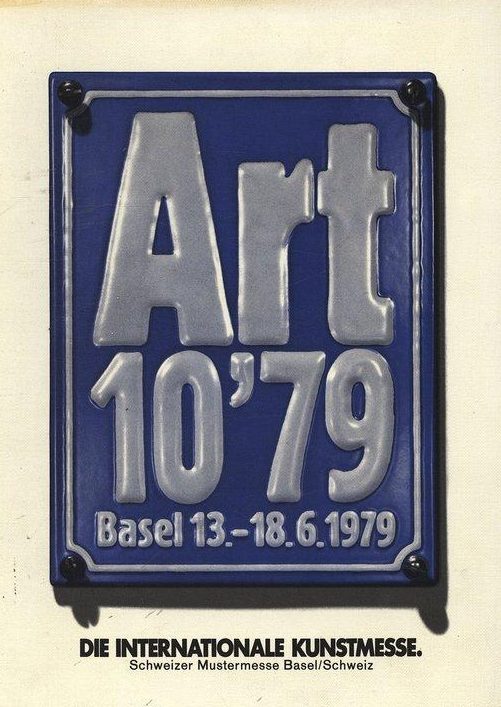Back in 1979, Art Basel was only ten years old. Art News & Review’s Michael Shepherd was sent to observe this exotic phenomenon – herald of the artworld to come. And one that now seems far away…
The white mouse ran purposefully up to the portable typewriter on the floor, placed his-her-its front paws on it with the assurance of a touch-typist, and twitched its nose like a journalist scenting a good leading paragraph. I cursed the fact that I wasn’t carrying a camera. But who was taking the mickey out of whom. . . ?
Basel Art Fair has just celebrated its 10th anniversary; proving not only its own justification for its existence with, this year, 268 exhibitors, 205 of them from outside Switzerland; but also that it is aware of the need to balance its market representation with a showplace for vanguard freedom and adventure. In addition to its evening programme of actions, video and suchlike, 16 rooms of 25 square metres each were set aside on the first floor of the exhibition hall, the Mustermesse, for ‘Perspective ’79’, a non-commercial section (all sales profits to the artists) which is to be a permanent feature of the fair in future. The 16 were selected by gallery owners of the Exhibitors’ Advisory Board; they were Boehlc, Kaminsky, Karius and Mirus from Germany; Disler, Federle and Walker from Switzerland; Clemente, Germana, Longobardi, Dc Maria, Paladino and Tatafiore from Italy; Robin Beers from Britain (RCA and RAS trained, works in the line of Richard Smith and Stephen Buckley, lives in Munich where he finds his market); Francisco from the USA; and General Idea (seen recently in London at Canada House) from Canada. The white mice were on one of these stands – on press day still under completion and anonymous.

This balance of vanguardism (though not a very exciting choice in general, rather deja-vu, at least to me) is all the more necessary since the increased cost of appearing at Basel has meant less space given by dealers to their ‘front-window’ loss-leader youngsters, more given to ‘stock-room’ art. This works, however, in the visitor’s favour to some extent: though it makes viewing the whole show more tiring, there are the rewards for the patient of catching a famous Magritte or some other museum-quality work tucked away. For dealers at Basel sell across the spectrum, from local impulse-buyers to the many collectors who live within range of Basel to fly over for its fair, and also to public museums and galleries.
Basel began in 1970 somewhat tentatively, with 110 exhibitors from 10 nations, 70 of whom were from outside Switzerland. It doubled both these figures by 1972. The highest numbers were in 1975 (311, 228 foreign), the year after the ‘art boom’ began to fade, and that year Britain was given a special national exhibit, as well as her 20 galleries. This year, we have 14 galleries exhibiting, in a strong showing mostly grouped together: Aberbach (showing Hundertwasser amid exotic foliage); Anima Graphics, mostly landscape; Fischer, very lively; Gilbert-Parr, continuing its crusade to put Portway on the international map; Hughes, with a fabulous ‘total-look’ collection of salon painting, rugs and art pottery to match, in the very midst of which is a Francis Bacon like a camouflaged time-bomb; Jacobson, on the map but not in the catalogue; Juda; Knoedler-Kasmin, with an exemplary show of Stephen Buckley, quite his best yet; Lisson, very much in the forefront at Basel; Piccadilly; Poole, a late entry featuring a retrospective of Richard Allen; Redfern, where Tapies still looks terrific; Treadwell, never failing to fascinate some and repel others; and Waddington.
The 23 nations represented this year omit Iran, Turkey and Finland from last year’s list, but include Australia and Hungary for the first time, as well as Greece, Israel, Portugal, Canada, Bulgaria, Poland and Japan. The number of US participants was down from 14 to 10, due to the unfavourable exchange between US dollar and Swiss franc; also American dealers, who used to have to come to Europe to acquire the status to sell to Americans who also came to Europe to buy, now sell to them back home instead. New York, Washington, San Francisco, all have their fairs now. Frankly, the American presence is much missed; its expansive, adventurous, confident, optimistic and forward-looking imagery – as exemplified by the big inked papers of Susan Weil on the Galleriet stand from Sweden – provide a corrective balance to the textural, spatial, mysterious, private, but often shallow-minded and undemanding imagery of a number of attractive European offerings. These are good second-line visual communication, sophisticated decoration (school-of altarpieces to modern art), but should not be promoted as new vision. The Swiss Mini-art Gallery puts the situation in perspective: fantasies that grate as 4 x 3-ft. museum canvases have a good-natured humour as 4 x 3-in. miniatures.
Dennis Oppenheim has a rather rhetorical retrospective at the Kunsthalle; Douglas Swan continues to look more interesting; so does Osvaldo Romberg; Alberto Garrutti manages to make minimalism elegant and interesting again; Claude Yvel has some deliciously atmospheric French provincial and urban realism; Hamilton and Roth’s Interfaces look good in Basel; Martin Schwarz has some witty transpositions of such as The Avenue at Middelhaniiss; Yoji Kuri has an agreeable mobile wit; Canon Photo Galleries have a selection to make photography exciting again; Ortncr impresses; Sonia Delaunay, Vieira da Silva and Bridget Riley were put together substantially; Beuys does everything, from non-commercial to limited-edition, authenticity- stamped white-painted coal shovels. At Basel as at every big art event, everything is informative, everything illuminating. Easy to say that we are well served in Britain; here is the evidence for and against; and mostly, for.
